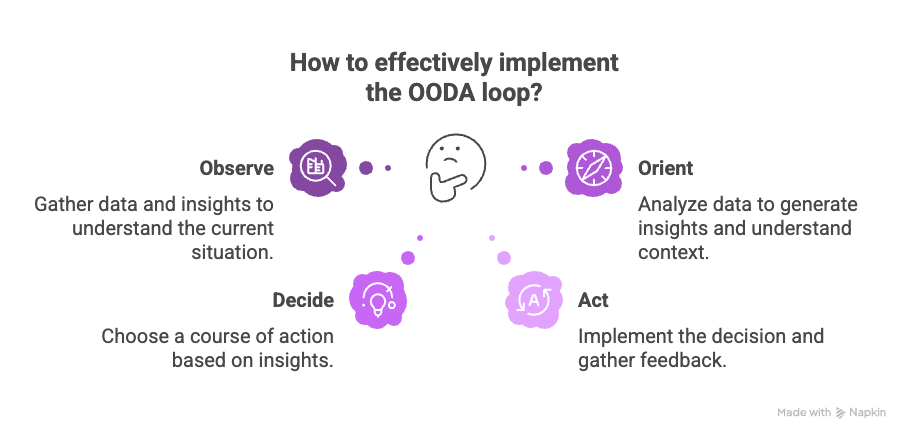What exactly is the OODA loop?
Elements of OODA
John Boyd, a former U.S. Air Force colonel, framed decision-making as a continuous four-step cycle: Observe, Orient, Decide, and Act. The loop explains how organisations can sense change, make sense of it, choose a response and carry it out—then feed the results back into the next cycle.
Competitive advantage now depends on shortening the time from market signal to product change. The OODA loop provides a practical structure for trimming that interval without compromising rigour, enabling product organisations to learn faster than their rivals and meet customer expectations with timely releases.
How does each step work in practice?
Observe – Capture quantitative data (usage analytics, financial metrics) and qualitative insight (customer interviews, field studies).
Orient – Filter those signals through culture, experience and analytical models to generate insight.
Decide – Generate options, assess trade-offs and select a course of action.
Act – Implement the decision by shipping a feature, running an experiment, or adjusting pricing, then gather outcome data for the next Observe step.
Is Orientation the most challenging part?
Orientation bears the cognitive load. Biases, legacy beliefs, and siloed information can distort the picture, causing feedback loops to reinforce the wrong behaviour. Structured sense-making rituals, diverse teams and transparent data pipelines counter that risk.
Does faster always mean better?
Tempo beats sheer speed. Running the loop just quickly enough to unsettle competitors and delight customers is the aim. Some choices merit slower loops to allow reflection; others require minutes. The art lies in matching loop tempo to the decision’s reversibility and potential impact.
How does the loop intersect with the Scrum framework?
Scrum’s pillars—transparency, inspection, adaptation—track directly to OODA.
· Transparency ↔ Observe: Clean, shared artefacts (backlog, definition of done, live metrics) expose reality.
· Inspection ↔ Orientation: Sprint review, daily scrum, and backlog refinement reinterpret reality against goals and mental models.
· Adaptation ↔ Decide + Act: Teams choose a response and implement it within the same sprint, feeding the results into the next cycle.
Both constructs emphasise tight feedback loops, a bias to evidence and the freedom to pivot when new information appears. Where OODA speaks to enterprise tempo, Scrum supplies a team-level routine that operationalises the same principles.
What structural moves embed OODA thinking?
Instrument products so that every feature emits usage data.
Run cross-disciplinary orientation sessions that include design, analytics and commercial voices.
Favour reversible bets and track “time-to-evidence” alongside time-to-market.
Automate deployment with feature flags and canary releases, allowing actions to hit production while insights remain fresh.
Which pitfalls derail adoption?
Speed obsession that sacrifices Orientation quality.
Telemetry locked in functional silos.
Heavy approval gates exist between the Decision-Making and Action-Taking Stages.
A hero culture that celebrates gut feelings over evidence.
How can loop fitness be measured?
Four leading indicators keep the organisation honest:
Observation latency – time from event to availability of clean data.
Orientation throughput – duration of synthesis and debate.
Decision cycle time – queue length for options awaiting approval.
Deployment lead time – commit-to-production interval.
Embedding OODA at scale transforms the product organisation into a sensing, thinking, and acting system that keeps strategy alive and execution timely.

